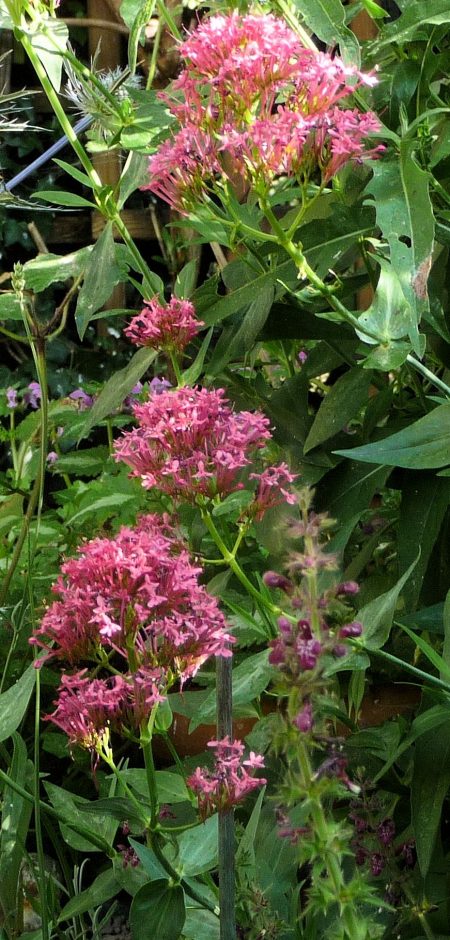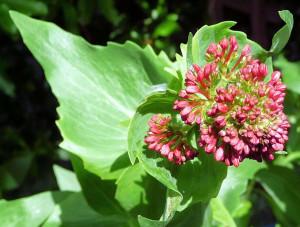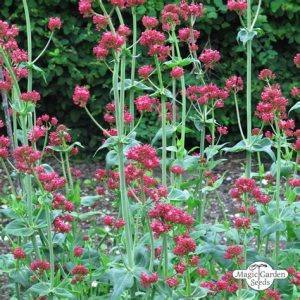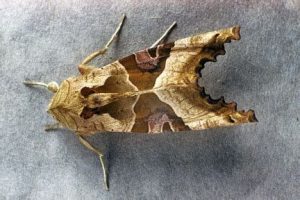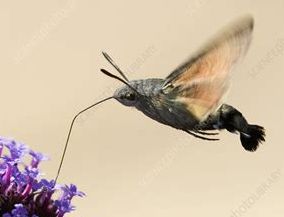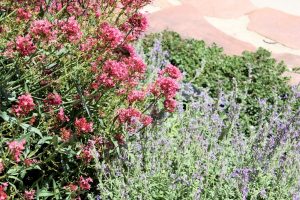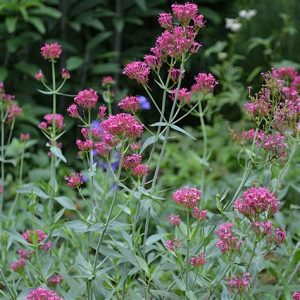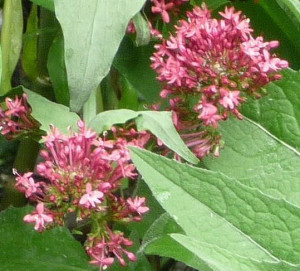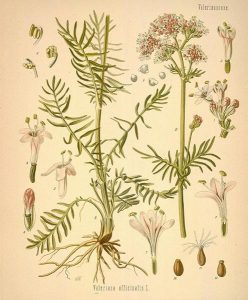RED VALERIAN (Centranthus ruber)
S Europe, Mediterranean to Turkey, N Africa
This sun-loving beauty from the Mediterranean, with its dense clusters of ROSY RED flowers & waxy green leaves, was introduced to the UK from Europe in the 1600s.
Now a favourite cottage garden flower, Centranthus ruber spills over walls & stony banks… it can be seen around Highbury in front gardens & in beds around street trees.
Red Valerian adapts to soils that are poor, alkaline, moist or dry, sandy or chalky, thriving on walls and in coastal gardens. It needs full sun to flower well.
Centranthus ruber blooms from April through to October. Remove spent flowerheads to encourage more blooms. Cut down stems in autumn ; this will prevent the formation of dandelion-like seed parachutes.
Bees and butterflies are attracted to Red Valerian. ‘Incredibly easy to grow and a magnet for pollinators.’ BBC Gardeners World Magazine
This plant will provide nectar & pollen for bees & many other types of pollinating insects, including the Hummingbird Hawk-Moth & the Angle Shades Moth.
‘The (Angle Shades Moth) caterpillars will eat the leaves of a wide range of different plants including nettles, red valerian, dock, bramble, hazel and oak. Can be seen in every month of the year’ David Chapman, Saga, 7 Nov 2012
‘As well as the Small Tortoiseshell featured at the top of this blog post, I have photographed Clouded Yellow, Glanville Fritillary and Painted Lady butterflies on the flowers…’
Jeremy Bartlett, http://www.jeremybartlett.co.uk/2019/01/03/red-valerian-centranthus-ruber/
Historical
It is naturally a native of the Mediterranean countries, and was probably originally introduced as a decorative plant. It is mentioned by many of the older writers as a garden flower. Gerard, writing in 1597, saying : ‘It groweth plentifully in my garden, being a great ornament to the same’. Parkinson (1640) says that it grows ‘in our gardens chiefly, for we know not the natural place’.
Linnaeus included this species with the Valerians, as Valeriana rubra, but De Candolle assigned it to a different genus, Centranthus… from the Greek kentron (a spur) and anthos (a flower)’.
Maud Grieve, A Modern Herbal 1931.
Edible
‘In some parts of continental Europe the leaves are eaten. They are exceedingly good in salad, or cooked as a vegetable, and in France there is a sale for the roots for soups.’ Maud Grieve, A Modern Herbal 1931.
‘This differs from our own experience : whilst the leaves can be added to salads they are rather bitter and rather less than desirable’. Plants for a Future
‘Richard Mabey says that the very young leaves are sometimes boiled with butter as greens or eaten raw in salads in France and Italy.’ quoted from Food for Free, Fontana, Glasgow 1975. Jeremy Bartett, http://www.jeremybartlett.co.uk/2019/01/03/red-valerian-centranthus-ruber/
How to Grow
Plants look best grown en masse on banks or when allowed to self-seed in walls and paving, where they create a delightful random, natural effect. A background of stone gives them an ideal setting, or they can be teamed with other cottage garden flowers in a border, such as lime-loving gypsophila, pinks and scabious.
BBC gardenersworld.com
Other names: Bouncing Bess, Bovisand Soldier, Cat’s Love, Delicate Bess, Devil’s Beard, Drunkards, Drunkard’s Nose, Drunken Sailor, Drunken Willy, Drunkits, Fox, Fox’s Brush, German Lilac, Gipsy Lace, Good Neighbourhood, Good Neighbours, Jupiter’s Beard, Keys to Heaven, Kiss Behind the Pantry, Kiss Me Quick, Kissing Kind, Kiss the Garden Door, Lady’s Needlework, Pretty Betsy, Red Spur Valerian, Scarlet Lightning, Spanish Valerian, Spur Valerian.
Unsuccessful at Highbury
Our first Valerian, ‘St George’, was a mix of white & red flowers grown from seed. It struggled with invading Bindweed tendrils from the concrete garden next door & was moved onto the earthwork. There it struggled with existing plants, as did its replacement.
Centranthus ruber is not to be confused with herbal Valerian (Valeriana officinalis), loved by cats & used by humans to treat insomnia.
Valeriana officinalis
The herb Valerian, Valeriana officinalis, is a different plant. A flowering plant with white flowers whose root has long been used as a herbal remedy to treat insomnia. The use of valerian root dates back to the Greek and Roman Empires and was noted by Hippocrates to treat headaches, nervousness, trembling, and heart palpitations.
Other names: All-heal, Amantilla, Baldrian, Bloody Butcher, Butcher’s Valerian, Cat’s Valerian, Capon’s Trailer, English Valerian, Fragrant Valerian, Garden Heliotrope, Phu, St George’s Herb, Sets Wale, Setwall, Tagar (Ayurvedic), Vandal Root, Xie Cao (traditional Chinese medicine.)
Sweaty socks and Valerian Root
Years ago a Valerian pillow was planned for Bertie, a cat who lived in Stoke Newington… I went to the Bread & Roses health food shop on Upper Street – & yes, they had Valerian root. It was in a large jar… as she opened the lid & a whiff of old sweaty socks wafted out, the assistant said ‘I hope you don’t think that’s ME!’
Friend Beryl made a small pillow for the Valerian root. She stitched ‘Bertie’ across it, & put it into a manila envelope with holes in it. This was addressed to Bertie. The Valerian aroma could be smelled through the holes in the envelope. The post office duly delivered it to Stoke Newington (probably wondering at the sorting office just who was this Bertie & what was his interest in sweaty socks).
Bertie’s humans, Angie & Ruth, got in touch… when the package came through the front door mail slot & dropped to the floor, Bertie had run into the hall… he returned dragging the aromatic package behind him. He KNEW it was meant for him, but needed help opening it. Once the smelly Bertie Pillow was brought out, it became his personal favourite, dragged from room to room. ‘Thank you so much, said our friends. ‘You shouldn’t have.’.
